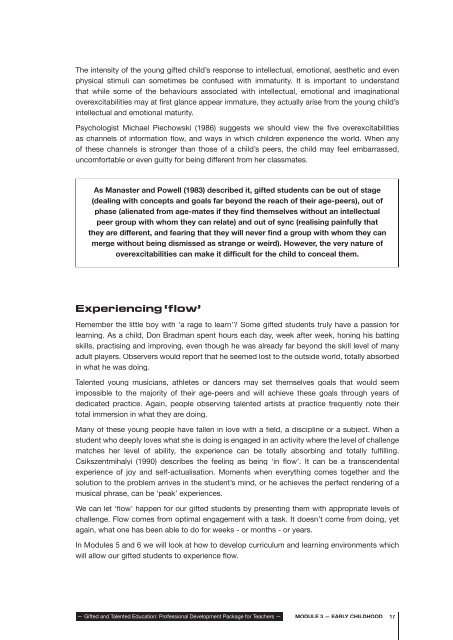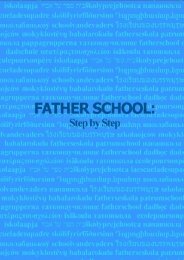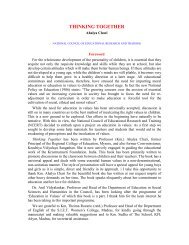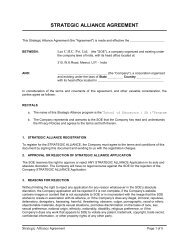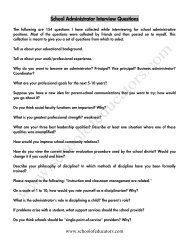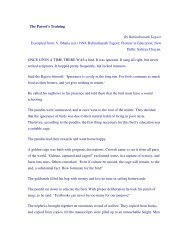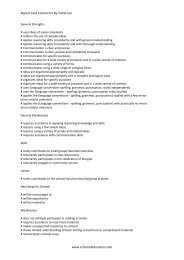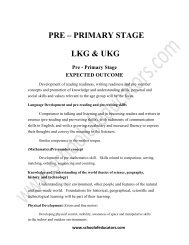Module 3 - School of Educators
Module 3 - School of Educators
Module 3 - School of Educators
- No tags were found...
You also want an ePaper? Increase the reach of your titles
YUMPU automatically turns print PDFs into web optimized ePapers that Google loves.
The intensity <strong>of</strong> the young gifted child’s response to intellectual, emotional, aesthetic and evenphysical stimuli can sometimes be confused with immaturity. It is important to understandthat while some <strong>of</strong> the behaviours associated with intellectual, emotional and imaginationaloverexcitabilities may at first glance appear immature, they actually arise from the young child’sintellectual and emotional maturity.Psychologist Michael Piechowski (1986) suggests we should view the five overexcitabilitiesas channels <strong>of</strong> information flow, and ways in which children experience the world. When any<strong>of</strong> these channels is stronger than those <strong>of</strong> a child’s peers, the child may feel embarrassed,uncomfortable or even guilty for being different from her classmates.As Manaster and Powell (1983) described it, gifted students can be out <strong>of</strong> stage(dealing with concepts and goals far beyond the reach <strong>of</strong> their age-peers), out <strong>of</strong>phase (alienated from age-mates if they find themselves without an intellectualpeer group with whom they can relate) and out <strong>of</strong> sync (realising painfully thatthey are different, and fearing that they will never find a group with whom they canmerge without being dismissed as strange or weird). However, the very nature <strong>of</strong>overexcitabilities can make it difficult for the child to conceal them.Experiencing ‘flow’Remember the little boy with ‘a rage to learn’? Some gifted students truly have a passion forlearning. As a child, Don Bradman spent hours each day, week after week, honing his battingskills, practising and improving, even though he was already far beyond the skill level <strong>of</strong> manyadult players. Observers would report that he seemed lost to the outside world, totally absorbedin what he was doing.Talented young musicians, athletes or dancers may set themselves goals that would seemimpossible to the majority <strong>of</strong> their age-peers and will achieve these goals through years <strong>of</strong>dedicated practice. Again, people observing talented artists at practice frequently note theirtotal immersion in what they are doing.Many <strong>of</strong> these young people have fallen in love with a field, a discipline or a subject. When astudent who deeply loves what she is doing is engaged in an activity where the level <strong>of</strong> challengematches her level <strong>of</strong> ability, the experience can be totally absorbing and totally fulfilling.Csikszentmihalyi (1990) describes the feeling as being ‘in flow’. It can be a transcendentalexperience <strong>of</strong> joy and self-actualisation. Moments when everything comes together and thesolution to the problem arrives in the student’s mind, or he achieves the perfect rendering <strong>of</strong> amusical phrase, can be ‘peak’ experiences.We can let ‘flow’ happen for our gifted students by presenting them with appropriate levels <strong>of</strong>challenge. Flow comes from optimal engagement with a task. It doesn’t come from doing, yetagain, what one has been able to do for weeks - or months - or years.In <strong>Module</strong>s 5 and 6 we will look at how to develop curriculum and learning environments whichwill allow our gifted students to experience flow.— Gifted and Talented Education: Pr<strong>of</strong>essional Development Package for Teachers — MODULE 3 — EARLY CHILDHOOD17


